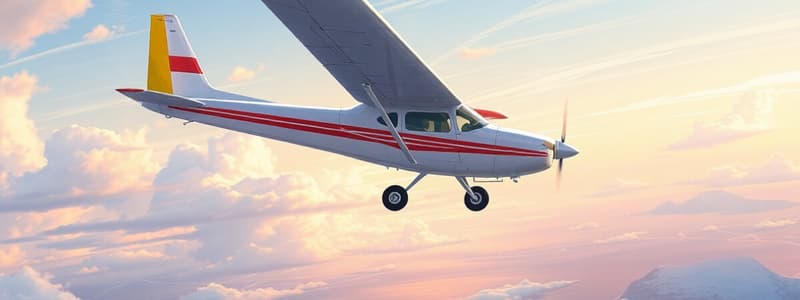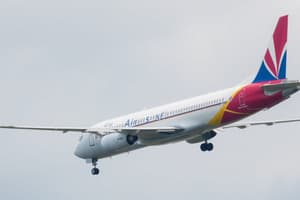Podcast
Questions and Answers
What is the purpose of Part 22 in the Aviation legislation?
What is the purpose of Part 22 in the Aviation legislation?
- To outline maintenance requirements for aircraft.
- To specify Airworthiness Standards for sailplanes. (correct)
- To define air traffic control procedures.
- To regulate pilot training programs.
Which category is NOT included under the Airworthiness Standards of Part 23?
Which category is NOT included under the Airworthiness Standards of Part 23?
- Normal
- Heavy (correct)
- Commuter
- Utility
What type of operation does Part 22 allow for aerobatic category sailplanes?
What type of operation does Part 22 allow for aerobatic category sailplanes?
- Unrestricted aerobatic operation.
- Only competition aerobatics.
- Limited aerobatic operation. (correct)
- Aerobatic operation only during daytime.
What does Part 23 regulate in terms of aircraft certification?
What does Part 23 regulate in terms of aircraft certification?
Which of the following is a type of sailplane specified in Part 22?
Which of the following is a type of sailplane specified in Part 22?
Which of the following is NOT a requirement for an organization to be approved as a CAMO?
Which of the following is NOT a requirement for an organization to be approved as a CAMO?
What document must be carried by the pilot in command when flying an aircraft?
What document must be carried by the pilot in command when flying an aircraft?
Which document is associated with the ongoing airworthiness of an aircraft?
Which document is associated with the ongoing airworthiness of an aircraft?
What must be provided if an aircraft is carrying cargo?
What must be provided if an aircraft is carrying cargo?
Which of the following describes the purpose of the exposition required for CAMO approval?
Which of the following describes the purpose of the exposition required for CAMO approval?
What is the requirement related to aircraft markings according to CASR Part 45?
What is the requirement related to aircraft markings according to CASR Part 45?
Which of the following must a pilot also carry in regards to the operating crew?
Which of the following must a pilot also carry in regards to the operating crew?
What is NOT required if an aircraft is carrying passengers?
What is NOT required if an aircraft is carrying passengers?
What does Part 21 of CASR 1998 primarily address?
What does Part 21 of CASR 1998 primarily address?
What is the purpose of Type Certification (TC) as described in Part 21?
What is the purpose of Type Certification (TC) as described in Part 21?
What is a prerequisite for obtaining a Certificate of Airworthiness (CofA) for an individual aircraft?
What is a prerequisite for obtaining a Certificate of Airworthiness (CofA) for an individual aircraft?
Which of the following is NOT governed by Part 21?
Which of the following is NOT governed by Part 21?
Which of the following statements about the structure of CASR 1998 is accurate?
Which of the following statements about the structure of CASR 1998 is accurate?
What is one of the key contents of Part 21 according to CASR 1998?
What is one of the key contents of Part 21 according to CASR 1998?
What do you need to refer to for interpretive guidance regarding the requirements in the CASR?
What do you need to refer to for interpretive guidance regarding the requirements in the CASR?
Part 22 of CASR 1998 is primarily concerned with which aspect?
Part 22 of CASR 1998 is primarily concerned with which aspect?
What does the Operational category of aircraft classification refer to?
What does the Operational category of aircraft classification refer to?
Which CASR Part pertains to small rotorcraft in the normal category?
Which CASR Part pertains to small rotorcraft in the normal category?
What type of aircraft is covered under a Special CofA?
What type of aircraft is covered under a Special CofA?
What is the primary purpose of a Supplementary Type Certificate (STC)?
What is the primary purpose of a Supplementary Type Certificate (STC)?
Which standard is issued for sailplanes and gliders?
Which standard is issued for sailplanes and gliders?
What is a Provisional Certificate of Airworthiness issued for?
What is a Provisional Certificate of Airworthiness issued for?
When is a Type Acceptance Certificate (TAC) issued by CASA?
When is a Type Acceptance Certificate (TAC) issued by CASA?
What must be provided to CASA before it issues a TAC?
What must be provided to CASA before it issues a TAC?
What does the Airworthiness category group aircraft based on?
What does the Airworthiness category group aircraft based on?
The classification of operation includes which types of operation?
The classification of operation includes which types of operation?
Which of the following is a category under which a TAC can be issued?
Which of the following is a category under which a TAC can be issued?
A TAC enables the issuance of what document for imported aircraft?
A TAC enables the issuance of what document for imported aircraft?
Which of the following is NOT a standard defined under CASR Part?
Which of the following is NOT a standard defined under CASR Part?
What does an STC represent in relation to an Australian-designed aircraft?
What does an STC represent in relation to an Australian-designed aircraft?
If a foreign TC does not have an equivalent category for a TAC, who determines the category to be shown?
If a foreign TC does not have an equivalent category for a TAC, who determines the category to be shown?
Which document must an applicant have to receive a TAC for a new aircraft type?
Which document must an applicant have to receive a TAC for a new aircraft type?
What does the nationality marking for Australian aircraft start with?
What does the nationality marking for Australian aircraft start with?
Which of the following is true regarding the registration marks for aircraft?
Which of the following is true regarding the registration marks for aircraft?
What material must an aircraft registration identification plate be made from?
What material must an aircraft registration identification plate be made from?
What is the consequence of operating an aircraft without an attached registration identification plate?
What is the consequence of operating an aircraft without an attached registration identification plate?
How must the aircraft registration identification plate be attached to the aircraft?
How must the aircraft registration identification plate be attached to the aircraft?
Which of the following components is NOT included in nationality and registration marks regulations?
Which of the following components is NOT included in nationality and registration marks regulations?
What must follow the letters 'VH' on an aircraft registration identification plate?
What must follow the letters 'VH' on an aircraft registration identification plate?
Under what condition might an aircraft be exempt from displaying nationality and registration marks?
Under what condition might an aircraft be exempt from displaying nationality and registration marks?
Flashcards
Nationality Marking
Nationality Marking
The part of an aircraft's marking that identifies the country of origin (e.g., VH for Australia).
Registration Marking
Registration Marking
The part of an aircraft's marking that uniquely identifies the specific aircraft (e.g., ABC).
Aircraft Registration Identification Plate
Aircraft Registration Identification Plate
A plate containing the nationality and registration marks, made of fireproof material, securely attached to the aircraft.
Aircraft Marking Location
Aircraft Marking Location
Signup and view all the flashcards
VH
VH
Signup and view all the flashcards
Aircraft Registration
Aircraft Registration
Signup and view all the flashcards
Fireproof Material
Fireproof Material
Signup and view all the flashcards
Accessible Location
Accessible Location
Signup and view all the flashcards
CAMO Approval Requirements
CAMO Approval Requirements
Signup and view all the flashcards
CASR Part 42
CASR Part 42
Signup and view all the flashcards
Required Aircraft Documents
Required Aircraft Documents
Signup and view all the flashcards
CAR 139
CAR 139
Signup and view all the flashcards
Aircraft Markings
Aircraft Markings
Signup and view all the flashcards
Certificate of Registration
Certificate of Registration
Signup and view all the flashcards
Certificate of Airworthiness
Certificate of Airworthiness
Signup and view all the flashcards
Maintenance Release
Maintenance Release
Signup and view all the flashcards
Type Certification (TC)
Type Certification (TC)
Signup and view all the flashcards
Certificate of Airworthiness (CofA)
Certificate of Airworthiness (CofA)
Signup and view all the flashcards
Production Certification
Production Certification
Signup and view all the flashcards
Type Acceptance Certificate (TAC)
Type Acceptance Certificate (TAC)
Signup and view all the flashcards
What does a TAC enable?
What does a TAC enable?
Signup and view all the flashcards
Where does the TAC information come from?
Where does the TAC information come from?
Signup and view all the flashcards
What is a continuing airworthiness data?
What is a continuing airworthiness data?
Signup and view all the flashcards
What does CASA consider when issuing a TAC?
What does CASA consider when issuing a TAC?
Signup and view all the flashcards
What's the role of the foreign TC?
What's the role of the foreign TC?
Signup and view all the flashcards
What happens before CASA issues a TAC?
What happens before CASA issues a TAC?
Signup and view all the flashcards
Airworthiness Standards
Airworthiness Standards
Signup and view all the flashcards
Sailplane Airworthiness
Sailplane Airworthiness
Signup and view all the flashcards
Aircraft Categories
Aircraft Categories
Signup and view all the flashcards
Operational Category
Operational Category
Signup and view all the flashcards
Airworthiness Category
Airworthiness Category
Signup and view all the flashcards
Standard Certificate of Airworthiness (CofA)
Standard Certificate of Airworthiness (CofA)
Signup and view all the flashcards
CASR Parts (22, 23, 25, etc.)
CASR Parts (22, 23, 25, etc.)
Signup and view all the flashcards
Special CofA
Special CofA
Signup and view all the flashcards
Special Flight Permits
Special Flight Permits
Signup and view all the flashcards
Initial Certification
Initial Certification
Signup and view all the flashcards
Amateur-Built Aircraft Acceptance (ABAA)
Amateur-Built Aircraft Acceptance (ABAA)
Signup and view all the flashcards
Study Notes
Registered Operator Responsibilities
- Registered Operators (ROs) must comply with safety regulations and local laws.
- ROs ensure employees and flight crews are aware of relevant regulations.
- A Compliance Statement evaluates applicants' Operations Manuals and Maintenance Control Manuals (where applicable).
- Aircraft operators need a current Certificate of Compliance from CASA, which verifies satisfactory passenger liability insurance.
Operator's Responsibilities for Continuous Airworthiness and Maintenance
- Continuing airworthiness requirements are ensured by the Registered Operator (RO) before an aircraft is permitted to fly.
- These requirements include: rectifying defects, adhering to Airworthiness Directives, using only approved modifications/repairs, replacing life-limited products, complying with an approved maintenance program, assessing maintenance program effectiveness, ensuring all operational/emergency equipment is serviceable and fitted, and maintaining a valid Airworthiness Review Certificate (ARC).
- A Continuing Airworthiness Review (CAR) is needed for any aircraft maintenance.
Minimum Equipment List (MEL)
- The Minimum Equipment List (MEL) is a document approved by CASA detailing conditions under which an aircraft can operate with inoperative equipment.
- MELs outline the timeframe for rectifying faulty items based on their operational significance.
Configuration Deviation List (CDL)
- The Configuration Deviation List (CDL) identifies external aircraft parts that may be missing at the commencement of flight.
- Examples of missing parts and associated performance impacts/limitations are included in the CDL.
Dispatch Deviation List/Guide (DDL/DDG)
- DDL, also known as DDG, includes both the MEL and CDL.
Operator's Responsibility to an Aircraft Maintenance Program
- CASR Subpart 42.C outlines continuing airworthiness requirements for aircraft and aeronautical products, including for CAMOs.
- Aircraft maintenance must adhere to a Part 145 approval.
- A Maintenance Program details scheduled maintenance tasks and their frequencies.
- The program should be reviewed annually, incorporating any revisions affecting the program.
Continuing Airworthiness Management Organisation (CAMO)
- CASR Part 42 separates CAMO’s responsibility for continued airworthiness from a Part 145 Organisation's responsibility for maintenance.
- An RPT operator (AOC holder) must be approved as a CAMO.
- Maintenance operations must be performed by Part 145 approved organisations.
Responsibilities of a CAMO
- A CAMO must ensure compliance with airworthiness directives, use only approved modifications/repairs, replace life-limited aeronautical products, and fulfill the Approved Maintenance Program.
- CAMOs must maintain an aircraft continuing airworthiness record system, including technical log systems, and have an Airworthiness Review Certificate (ARC) for the aircraft.
- Ongoing airworthiness tasks must be achieved before an aircraft can fly.
- This includes pre-flight inspections, rectifying defects, and ensuring equipment serviceability
Requirements for Approval of a CAMO by CASA
- An organisation seeking CAMO approval needs adequate facilities/equipment, access to continuing airworthiness instructions, qualified personnel, and processes for fulfilling regulatory obligations.
- CASR Part 42 Subpart G details initial and subsequent CAMO approvals.
Documents to be Carried in an Australian Aircraft
- CAR 139 mandates that the pilot carries required documents, including the aircraft's registration certificate, airworthiness certificate, maintenance release or continuing airworthiness review (CRS), crew licenses/medical certificates, flight manuals, any relevant radio licenses, passenger lists, and cargo manifests.
CASR Part 45 Aircraft Marking Requirements
- Australian aircraft must have specified markings, including nationality and registration marks, and registration identification plates.
- The location, sizing and spacing of markings are regulated.
Nationality and Registration Marks
- Nationality and registration marks consist of two parts: nationality marking (e.g., VH) and registration marking (e.g., ABC), separated by a hyphen (e.g., VH-ABC).
- Certain aircraft may be exempt from displaying these markings under specific conditions.
Identification Plates
- Aircraft registration plates must be affixed in an accessible location, be made of fireproof material, and have the nationality and registration marks.
- Defacement or detachment of the plate is a violation.
Identifying Words
- Restricted aircraft categories necessitate specific identifying words (e.g., Limited, Restricted, Provisional, Experimental) on the aircraft.
Safety Signs
- Safety placards must be displayed on Australian aircraft to alert pilots and passengers about safety requirements/hazards, including no smoking, seatbelt use, fire locations, and emergency exits.
- Rescue crew access areas must be clearly marked.
Placards
- Essential aircraft parts, these are safety aids recorded in illustrated parts listings and catalogues.
- They indicate inoperative equipment and may be subject to Airworthiness Directives.
Certification of Aircraft, Parts and Appliances I (10.5)
- This topic covers the structure and intent of CASR Parts 21, 23, 25, 27, and 29, including the purpose and issue processes for standard/special/restricted Certificates of Airworthiness.
Part 21 Certification and Airworthiness
- Part 21 covers the certification and airworthiness requirements for civil aircraft.
- It includes type certification (TC), airworthiness certification, production certification, and approvals for aircraft engines, propellers, materials, parts, processes, and appliances for certain types of aircraft.
- Aircraft type certification (evaluating and approving aircraft design data) is required before a Type Certificate can be issued and a Certificate of Airworthiness (CofA) can be issued for an individual aircraft.
Type Certificate Issue of Type Certificates
- A Type Certificate is a document issued by CASA to define the design and certification of aircraft, engines or propellers which meet all the applicable airworthiness requirements.
Certification of an Aircraft Type
- Type certification procedures outline design standards and requirements for testing, analysis, flight testing, manufacturing, and maintaining acceptable operating characteristics.
Supplemental Type Certificate (STC)
- An STC allows modifications to a type-certificated aircraft, engine or propeller, as long as the modification is approved, meets the design and airworthiness standards.
Type Acceptance Certificates (TAC)
- A TAC is a document issued by CASA permitting an approved foreign type design for Australian aircraft.
- A TAC facilitates the issuance of a Certificate of Airworthiness (CofA) for imported aircraft.
Application for a Type Certificate
- Aircraft type certificates require specific documentation, including drawings, preliminary data, and detailed designs including engine type and limitations.
Type Certificate Data Sheet (TCDS)
- This document by the NAA contains airworthiness requirements and general design details.
- It outlines specifics about the aircraft, engine, propeller, and other key aspects.
Airworthiness Certification (Meaning)
- A Certificate of Airworthiness (CofA) is a necessary condition for operating a registered Australian aircraft.
- It refers either to a Standard CofA (for aircraft in designated categories like Normal, Utility, or Acrobatic) or a Special CofA (for other categories).
Certification Categories and Designation
- Aircraft are categorised both operationally and by airworthiness standards (e.g., CASR Parts 21, 22, 23, 25, 27, and 29).
- This categorization determines type design criteria and standards which are applied depending on operational requirements.
Issuing a Special Certificate of Airworthiness
- Special CofAs are issued for aircraft not meeting standard criteria, with certain requirements and categories (e.g., agricultural, forest conservation, and weather control operations).
Restricted Certificates of Airworthiness
- Restricted Category TCs are necessary for aircraft designed or modified for specific purpose operations.
Certificate of Airworthiness (CofA) Application Process (Aircraft Data)
- This process outlines data required from applicants for CofA approvals when an aircraft is being based in Australia, imported, modified or in new/used condition.
Foreign Aircraft
- Specific Australian authorities issue TACs for foreign-built aircraft types that already have a valid TC in another country. This is done based on specified documentation standards set by CASA for foreign aircraft.
Duration of the CofA
- A CofA's duration depends on the Certificate's specified period or until cancellation in case of non-compliance.
Studying That Suits You
Use AI to generate personalized quizzes and flashcards to suit your learning preferences.
Related Documents
Description
Test your knowledge about Parts 22 and 23 of the aviation legislation. This quiz covers the purpose of Part 22, the airworthiness standards in Part 23, and the regulations surrounding aerobatic category sailplanes. Challenge yourself and see how well you understand these important aviation rules.




